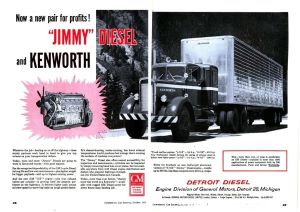 Did you know the Detroit Diesel 12V71, first introduced in 1957, earned its nickname “Screaming Jimmy” because of the high-pitched whine produced by its Roots-type supercharger forcing air into the engine? This iconic V12 two-stroke diesel wasn’t the only “Jimmy” on the block—it belonged to a larger family of Detroit Diesel engines that revolutionized transportation and industry.
Did you know the Detroit Diesel 12V71, first introduced in 1957, earned its nickname “Screaming Jimmy” because of the high-pitched whine produced by its Roots-type supercharger forcing air into the engine? This iconic V12 two-stroke diesel wasn’t the only “Jimmy” on the block—it belonged to a larger family of Detroit Diesel engines that revolutionized transportation and industry.
The 12V71 was designed to meet the demand for a powerful, reliable engine capable of delivering massive torque and horsepower. Industries like logging, mining, construction, and long-haul trucking relied on it to haul heavy loads in tough conditions. With 12 cylinders displacing 71 cubic inches each, it packed a whopping 852 cubic inches (13.9 liters) of displacement, producing up to 600 horsepower and over 1,500 lb-ft of torque. Trucks running this engine required twin stacks to handle the exhaust flow from its two banks of cylinders.
The Jimmy Diesel family, however, offered more than just the 12V71. Detroit Diesel’s 71 Series included configurations like the 4-71 and 6-71 inline engines and the 8V71 V8, all sharing the same two-stroke roots and rugged design. Later series, such as the 53 Series and 92 Series, expanded the lineup for lighter and heavier-duty applications, cementing the "Jimmy" legacy across industries.
The 12V71's two-stroke design relied on a scavenging-type Roots blower to push fresh air into the cylinders and expel exhaust gases, ensuring proper combustion without a dedicated intake or exhaust stroke. Some models enhanced this system with a turbocharger, creating a high-performance “turbo-blower” setup. Trucks like the Kenworth W900, Peterbilt 359, Diamond Reo Giant, and International Harvester Paystar, powered by the 12V71, stood out for their performance, signature roar, and rolling coal.
Running at 1,800 to 2,100 RPM, the 12V71 delivered peak power for highway and industrial use. Its mechanical unit injectors provided precise fuel delivery, while a 10-gallon oil capacity and a robust water-cooling system ensured reliability. Weighing 3,150 pounds, it balanced its size with exceptional performance for its time.
While production of the 12V71 ended in the 1990s due to stricter emissions standards, its legacy endures. Restored rigs and other Detroit Diesel-powered vehicles still dominate vintage truck shows, their “Screaming Jimmy” engines serving as a powerful reminder of an era when Detroit Diesel’s sound and innovation ruled the road.
___
Discover trucking history for just $2 a month with the ATHS $24 Annual Online Membership! Get full access to American Truck Historical Society member benefits and the Wheels of Time digital magazine six times a year. Upgrade anytime for the print edition. Join now! aths.org/membership/become-a-member.